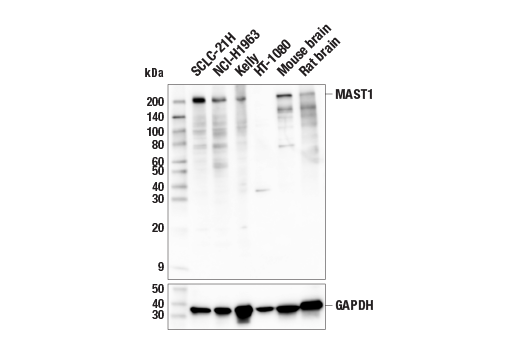WB
H M R
Endogenous
210
Rabbit IgG
#Q9Y2H9
22983
Product Information
Product Usage Information
| Application | Dilution |
|---|---|
| Western Blotting | 1:1000 |
Storage
Specificity / Sensitivity
Species Reactivity:
Human, Mouse, Rat
Source / Purification
Monoclonal antibody is produced by immunizing animals with a synthetic peptide corresponding to residues surrounding Lys764 of human MAST1 protein.
Background
MAST1 is a member of the microtubule-associated serine/threonine kinase (MAST) family of protein kinases. It possesses a serine/threonine kinase domain and a PDZ domain, the latter being important for its function as a scaffold molecule linking the dystrophin and utrophin complex with microfilaments (1,2). Expression of the gene encoding MAST1 is upregulated following glucocorticoid receptor activation, while MAST1 protein expression levels can be maintained by complex formation with HSP90B, protecting MAST1 from degradation (3,4). MAST1 gene rearrangements have been found in breast cancers, where MAST1 was reported to promote cell proliferation and tumor growth (5). MAST1 was also identified as a critical factor involved in the development of cisplatin resistance, via binding and phosphorylation of MEK1 that led to inhibition of apoptosis (6). MAST1 also plays an important role in neuron development and function (7). Numerous mutations in the gene encoding MAST1 are reported to associate with neural disorders, including mega-corpus-callosum syndrome, congenital bilateral perisylvian syndrome (CBPS), and intellectual disability (ID) (8-10).
- Garland, P. et al. (2008) Brain Res 1195, 12-9.
- Lumeng, C. et al. (1999) Nat Neurosci 2, 611-7.
- Pan, C. et al. (2019) J Clin Invest 129, 4110-4123.
- Pan, C. et al. (2021) Nat Commun 12, 4960.
- Robinson, D.R. et al. (2011) Nat Med 17, 1646-51.
- Jin, L. et al. (2018) Cancer Cell 34, 315-330.e7.
- Jing, T. et al. (2020) FEBS Open Bio 10, 1104-1114.
- Tripathy, R. et al. (2018) Neuron 100, 1354-1368.e5.
- Hecher, L. et al. (2020) Neuropediatrics 51, 435-439.
- Ben-Mahmoud, A. et al. (2020) J Mol Neurosci 70, 320-327.
Species Reactivity
Species reactivity is determined by testing in at least one approved application (e.g., western blot).
Western Blot Buffer
IMPORTANT: For western blots, incubate membrane with diluted primary antibody in 5% w/v BSA, 1X TBS, 0.1% Tween® 20 at 4°C with gentle shaking, overnight.
Applications Key
WB: Western Blotting
Cross-Reactivity Key
H: human M: mouse R: rat Hm: hamster Mk: monkey Vir: virus Mi: mink C: chicken Dm: D. melanogaster X: Xenopus Z: zebrafish B: bovine Dg: dog Pg: pig Sc: S. cerevisiae Ce: C. elegans Hr: horse GP: Guinea Pig Rab: rabbit All: all species expected
Trademarks and Patents
Limited Uses
Except as otherwise expressly agreed in a writing signed by a legally authorized representative of CST, the following terms apply to Products provided by CST, its affiliates or its distributors. Any Customer's terms and conditions that are in addition to, or different from, those contained herein, unless separately accepted in writing by a legally authorized representative of CST, are rejected and are of no force or effect.
Products are labeled with For Research Use Only or a similar labeling statement and have not been approved, cleared, or licensed by the FDA or other regulatory foreign or domestic entity, for any purpose. Customer shall not use any Product for any diagnostic or therapeutic purpose, or otherwise in any manner that conflicts with its labeling statement. Products sold or licensed by CST are provided for Customer as the end-user and solely for research and development uses. Any use of Product for diagnostic, prophylactic or therapeutic purposes, or any purchase of Product for resale (alone or as a component) or other commercial purpose, requires a separate license from CST. Customer shall (a) not sell, license, loan, donate or otherwise transfer or make available any Product to any third party, whether alone or in combination with other materials, or use the Products to manufacture any commercial products, (b) not copy, modify, reverse engineer, decompile, disassemble or otherwise attempt to discover the underlying structure or technology of the Products, or use the Products for the purpose of developing any products or services that would compete with CST products or services, (c) not alter or remove from the Products any trademarks, trade names, logos, patent or copyright notices or markings, (d) use the Products solely in accordance with CST Product Terms of Sale and any applicable documentation, and (e) comply with any license, terms of service or similar agreement with respect to any third party products or services used by Customer in connection with the Products.
